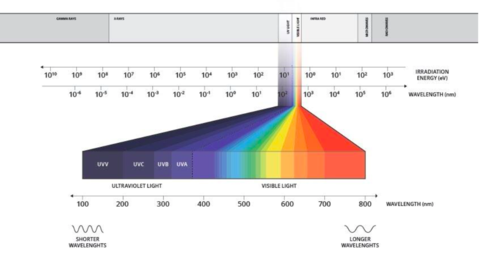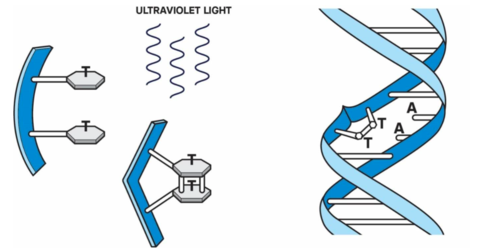Opira not only offers the highest quality UVC solutions for air purification and odour control, we also have specialists on hand to correctly install UV lights for the best performance.
Installing UV lights in your rooms or HVAC system can reduce or prevent microorganisms from travelling through the air within you building.
UV sterilisation has been popular since the 1940s and as of 2020 is being tested for effectiveness against COVID-19.
Here are answers to some of the common questions we receive about germicidal UV light systems.
What is UV light?
Light is electromagnetic radiation. And it’s measured along a spectrum, in billionths of a metre – a nanometre.
Visible light is the electromagnetic radiation that can be detected by the human eye and exists within the range of 380 nm and 760 nm.
UV is invisible to the human eye. From Latin, it literally means ‘beyond violet’ which is in reference to its position along the electromagnetic spectrum, occupying the wavelength from 10 nm to 400 nm. It’s shorter than the wavelength of visible light but longer than the wavelength of X-rays.

UV light can be further categorised into 4 ranges:
UVA – 315 nm to 400 nm
Of the light generated by the Sun – about 10% is UV radiation, and only 3-4% of that UV radiation penetrates the Earth’s atmosphere to reach the ground. Of the UV radiation that reaches Earth, 95% is UVA rays.
UVA is the range of light produced with a Woods Lamp and it has been used for printing, curing, lithography, sensing and medical applications.
UVB – 280 nm to 315 nm
UVB light makes up about 5% of the UV radiation that reaches the Earth’s surface. It’s UVB radiation that promotes the human body to produce vitamin D. UVB light can be used to for curing and in medical applications.
UVC – 200 nm to 280 nm
The Sun produces UV radiation at all wavelengths, but not all of it reaches the Earth’s surface. UVC radiation ionises air so strongly that it’s absorbed before it even reaches the Earth’s surface.
It’s UVC light that’s most effective for air and surface disinfection.It is sometimes incorrectly referred to as UVGI light. UVGI stands for Ultra Violet Germicidal Irradiation – which is the encompassing term for the UV method of disinfection, rather than the specific wavelength.
UVV – under 200 nm
These short light waves can only be produced in a vacuum. These wavelengths produce ozone (O3) in the air, but in properly controlled environments, they can reduce the carcinogenic effects of harmful VOCs, small bacteria carrying particles, like pet dander, and nicotine smoke.
How does UVC work for air purification?
It actually breaks apart organisms at a DNA level… but if you want to get all science-y it’s called a Pyrimidine Dimer.

Because of the spectral sensitivity of DNA and RNA, exposing an organism to enough UVC light will breakdown the nucleic acids at the Carbon, Hydrogen, Oxygen and Nitrogen single covalent bonds.
On top of that, once those bonds are broken, CPDs (cyclobutene pyrimidine dimers) and 6-4 PP’s (pyrimidine-pyrimidone 6-4 photoproducts) form mutations at the thymine or cytosine bases of the DNA.
These mutations are bonds forming between adjacent pyrimidines. UV irradiation mostly causes the thymine receptors to bond together – these mutated bonds are referred to as thymine dimers.
Are all UV-C lights created equal?
In fact, no they aren’t. You’ll first need to ensure that you’ve picked the right UV light for your needs. As it turns out the glass on the UV tube has an impact on the frequency of UV radiation that is transmitted through it. The higher quality the glass the more controlled the light wavelength will be. The optimal wavelength for germicidal irradiation is 254nm.
It’s also not just the wavelength that you want to optimise for, it’s the time that the air or surface is exposed to the light and the strength of that light – i.e. the further away the object to be sterilised is from the light source, the longer it will need to be exposed to inactivate micro-organisms. For air sterilisation, you’ll need to consider the speed at which the air flows past the lamp banks as this will impact exposure time.
The other important factor to consider is what micro-organisms, (viruses, bacteria or fungi) you are trying to control. This is because some micro-organisms are more sensitive to the UV-C radiation than others. In general, larger micro-organisms like bacteria are more sensitive than viruses – which tend to be smaller.
If you really love maths, you can calculate the correct UV dose using the following methodology:
UV dose (μW·s/cm2) = UV intensity (μW/cm2) × exposure time (seconds)
But, Opira relies on Sanuvox modelling software to accurately calculate your sterilisation requirements. It means you’ll get the most out of your system and you don’t have to worry that you’re over or under specifying the number of lights – which will save you money and help you more accurately budget for UV bulb replacements over the lifetime of your system.
Simply request a quote and we can walk you through all the details.
What types of systems are available?
UVGI solutions can generally be broken down into two main categories, HVAC and in-room, in both categories we offer solutions for air, surface sterilisation and/or odour control.
HVAC UV Sterilisation Products
- Biowall – Air Sterilisation
- IL Coil Clean – Surface Sterilisation
In-RoomUV SterilisationProducts
- Sanuvair S300 – Air Sterilisation and Odour Control
- ASEPT.1X MAX – Surface Sterilisation
- Sanuvair S100 – Air Sterilisation
Do I still need to use air filters if I have an in-duct UV solution?
In short, yes. Air filters, especially HEPA filters are great for not only controlling micro-organisms, but also for protecting expensive components in your HVAC system – so they actually work really well in tandem. Not every building needs the same level of protection against micro-organisms – for example a hospital operating theatre must meet higher standards of indoor air quality than an office block, it’s not simply the design of the building that matters – it’s the needs of the people that interact with your indoor environment.




